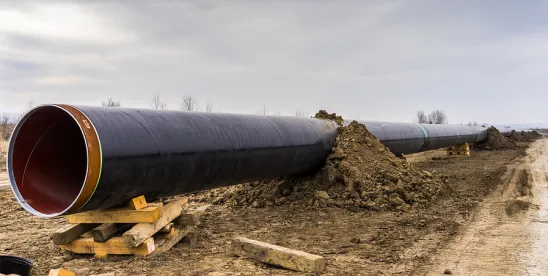On May 21, 2025, the Pipeline and Hazardous Materials Safety Administration (PHMSA) published an Advance Notice of Proposed Rulemaking (ANPRM) seeking stakeholder input on potential opportunities to improve the cost-effectiveness of the current repair requirements applicable to gas transmission pipelines and hazardous liquid or carbon dioxide pipelines contained in 49 C.F.R. Part 192 and Part 195 of the federal pipeline safety regulations. PHMSA also seeks input on authorizing risk-based inspection procedures for determining inspection intervals for in-service breakout tanks under Part 195. Comments are due July 21, 2025.
The ANPRM explains that current pipeline safety standards address the remediation of anomalies in pipeline facilities through both prescriptive requirements that generally apply to all pipelines and risk-based integrity management (IM) requirements that apply to pipeline segments posing risks to “high consequence areas.” PHMSA notes that some repair requirements have not been updated for decades and may not account for the latest advances in pipeline safety technologies and industry best practices. Updating repair criteria may be needed to align with recent changes to Part 192 and Part 195 regulations, to minimize barriers to the development and deployment of innovation, safety technologies and industry best practices, and to avoid overlapping regulatory requirements.
In addition, with respect to the inspections of in-service hazardous liquid breakout tanks, PHMSA notes that, while § 195.432 allows limited flexibility to use alternative inspection intervals contained in consensus standards, the regulation retains the default annual inspection requirement and does not authorize using risk-based inspection procedures to establish inspection intervals for in-service atmospheric and low-pressure steel above-ground breakout tanks.
To inform the agency’s development of proposed regulatory amendments to Part 192 and Part 195 in a future notice of proposed rulemaking (NPRM), the ANPRM poses numerous specific questions regarding existing anomaly repair criteria, remediation timelines, and IM regulations applicable to gas transmission pipelines under Part 192 and hazardous liquid pipelines and carbon dioxide pipelines under Part 195. The ANPRM also poses questions about the assessment and remediation of in-service Part 195-regulated hazardous liquid pipeline breakout tanks.
The ANPRM also requests feedback on the following:
- potential amendments to Part 192 and Part 195 repair criteria, remediation timelines, and IM requirements;
- the appropriateness of those amendments for different types of gas transmission pipelines and hazardous liquid or carbon dioxide pipelines;
- the incremental compliance costs and benefits, including benefits pertaining to avoided compliance costs, safety harms, and environmental harms; and
- the technical feasibility, reasonableness, cost-effectiveness, and practicability of those potential amendments.
With respect to cost and benefit information, PHMSA requests that stakeholders submit per-unit, aggregate, and programmatic (both one-time implementing and recurring) data. The ANPRM states that explaining the bases or methodologies employed in generating cost and benefit data, including data sources and calculations, will help PHMSA support cost and benefit benefits in an NPRM.
After receiving comments on the ANPRM, PHMSA states that it intends to convene a public meeting to supplement or clarify comments and materials received.






 />i
/>i
